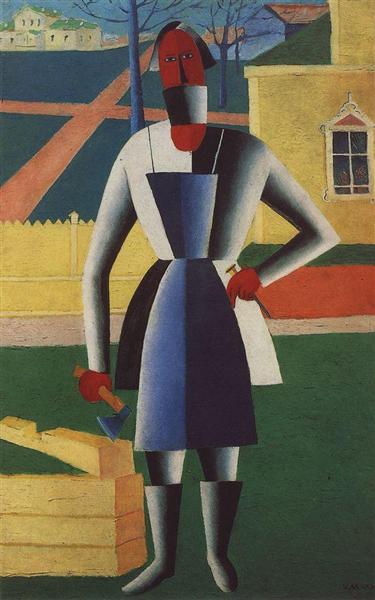Description
In the serene stillness that characterizes the mature works of Kazimir Malevich, carpenter 1929 emerges as a representation rich in symbolism and compositional synthesis that adheres to the fundamental principles of suprematism and simultaneously moves away in the direction of a more figurative approach. In this work, Malevich invites us to reflect on everyday life through an interpretation that mixes geometric abstraction with the human figure, a significant turn in its artistic career.
The painting shows a carpenter, portrayed schematically and austerely, standing with tools in hand, symbol of human work and material creation. In contrast to abstract forms and color planes that dominated their suprematist practice, Malevich gives the carpenter a recognizable, but stylized identity, using simplified forms that refer to their characteristic visual language. The straight lines and the flat shapes that constitute the body of the carpenter are reminiscences of the geometric structures that prevail in their suprematist work, underlining a persistent stylistic cohesion even in its most figurative turn.
The colors in Carpenter 1929 are vibrant and determined, mainly using tones of blue, red, black and white, a palette that not only gives dynamism to the figure but also refers to the clarity and purity of the creative act. Male and robust, the central figure seems suspended in a static stillness against a neutral background, directing all the attention to the essential elements of the composition.
It is essential to highlight that this work arises in a late period in Malevich's career, when the artist returns to certain figurative representations after his intense experimentation with total abstraction. This return does not represent an abandonment of the ideals of suprematism, but rather, an integration of these principles with a new exploration of content and form. In this sense, Carpenter 1929 can be interpreted as a point of convergence, where formal rigor and symbolism are in perfect harmony.
Malevich, mainly recognized as the founder of suprematism, a movement that exalts the supremacy of pure artistic sensibility on the visual forms of nature, maintains in this work the exposure of its philosophical and aesthetic convictions. Supremeism, with its emphasis on abstraction and simplification, seeks a form of mystical and transcendental contemplation, which is interferenced in carpenter 1929, translated into a more accessible and tangible iconography.
The carpenter, a day -to -day worker, is dignified through Malevich's supreme gaze, a look that seeks essence and purity in each representation. In certain aspects, this work keeps a spiritual relationship with its suprematist canvases, since both explore the nature of reality and perception, although through different means.
Thus, Carpenter 1929 of Kazimir Malevich not only captures the double insistence of the artist in the form and content, but also provides a window to the constant evolution of his understanding of art and its purpose. This work serves as a enduring testimony of how Malevich saw the world: through the simplicity of forms, the rigor of color and a deep appreciation for the dignity of the common worker.
KUADROS ©, a famous paint on your wall.
Hand-made oil painting reproductions, with the quality of professional artists and the distinctive seal of KUADROS ©.
Art reproduction service with satisfaction guarantee. If you are not completely satisfied with the replica of your painting, we refund your money 100%.

